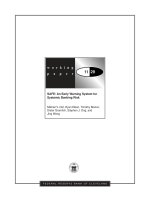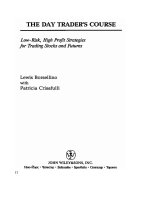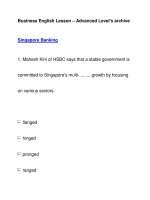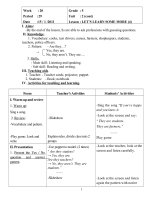Hennie van greuning s analysing banking risk (textbook)
Bạn đang xem bản rút gọn của tài liệu. Xem và tải ngay bản đầy đủ của tài liệu tại đây (7.63 MB, 442 trang )
Public Disclosure Authorized
Analyzing Banking Risk
A Framework for Assessing Corporate
Governance and Risk Management
THIRD EDITION
blic Disclosure Authorized
Public Disclosure Authorized
Public Disclosure Authorized
48238
Hennie van Greuning
Sonja Brajovic Bratanovic
Analyzing Banking Risk
A Framework for Assessing
Corporate Governance and
Risk Management
Analyzing Banking Risk
A Framework for Assessing
Corporate Governance and
Risk Management
3rd Edition
Hennie van Greuning
Sonja Brajovic Bratanovic
WASHINGTON, D.C.
© 2009 The International Bank for Reconstruction
and Development/THE WORLD BANK
1818 H Street, N.W.
Washington, D.C. 20433
All rights reserved
Manufactured in the United States of America
First printing November 1999
Second edition April 2003
Th ird edition April 2009
The findings, interpretations, and conclusions expressed in this book are entirely those of the authors and
should not be attributed in any manner to the World Bank, to its affi liated organizations, or to members
of its Board of Executive Directors or the countries they represent. The World Bank does not guarantee
the accuracy of the data included in this publication and accepts no responsibility for any consequence of
their use.
The material in this publication is copyrighted. The World Bank encourages dissemination of its work
and will normally grant permission to reproduce portions of the work promptly.
Permission to photocopy items for internal or personal use, for the internal or personal use of specific
clients, or for educational classroom use is granted by the World Bank, provided that the appropriate fee
is paid directly to the Copyright Clearance Center, Inc., 222 Rosewood Drive, Danvers, MA 01923,
USA.; telephone 978-750-8400, fax 978-750-4470. Please contact the Copyright Clearance Center
before photocopying items.
For permission to reprint individual articles or chapters, please fax a request with complete information to the Republication Department, Copyright Clearance Center, fax 978-750-4470.
All other queries on rights and licenses should be addressed to the Office of the Publisher, World
Bank, at the address above or faxed to 202-522-2422.
Design services by EEI Communications
ISBN 978-0-8213-7728-4
eISBN 978-0-8213-7898-4
DOI: 10.1596/978-0-8213-7728-4
Library of Congress Cataloging-in-Publication Data has been requested.
Contents
Foreword to the Th ird Edition
xiii
Acknowledgments
xv
1
Overview of Banking Risks
1.1 Introduction: The Changing Bank Environment
1.2 Bank Exposure to Risk
1.3 Corporate Governance
1.4 Risk-Based Analysis of Banks
1.5 Analytical Tools Provided
1
1
3
4
7
10
2
A Framework for Risk Analysis
2.1 Financial Management
2.2 Why Banks Are Analyzed
2.3 Understanding the Environment in Which Banks Operate
2.4 The Importance of Quality Data
2.5 Risk-Based Analysis of Banks
2.6 Analytical Tools
2.7 Analytical Techniques
13
13
16
17
24
27
29
34
3
Corporate Governance
3.1 Corporate Governance Principles
3.2 Major Developments in Corporate Governance Principles
3.3 Regulatory Authorities: Establishing a Risk-Based Framework
3.4 Supervisory Authorities: Monitoring Risk Management
3.5 The Shareholders: Appointing the Right Policy Makers
3.6 The Board of Directors: Ultimate Responsibility for a Bank’s Affairs
3.7 Management: Responsibility for Bank Operations and the
Implementation of Risk Management Policies
3.8 The Audit Committee and Internal Auditors:
An Extension of the Board’s Risk Management Function
41
41
44
46
48
51
53
59
64
vi
Analyzing Banking Risk
3.9
External Auditors: A Reassessment of the Traditional Approach of
Auditing Banks
3.10 The Role of the General Public
Annex 3A: National Initiatives to Improve Corporate Governance
66
67
71
4
Balance Sheet Structure
4.1 Introduction: Composition of the Balance Sheet
4.2 Bank Assets
4.3 Bank Liabilities
4.4 Equity and Other Items
4.5 Growth and Changes in the Balance Sheet
4.6 Risk Analysis of the Balance Sheet Structure and Growth
81
81
84
88
92
94
96
5
Income Statement Structure
5.1 Profitability
5.2 Income Statement Composition
5.3 Analyzing the Sources of Banking Income
5.4 Analyzing Quality of Earnings
5.5 Analysis of Profitability Indicators and Ratios
5.6 Assessing Internal Performance
101
101
103
107
109
113
118
6
Capital Adequacy
6.1 Introduction: The Characteristics and Functions of Capital
6.2 Capital Adequacy Standards and the Basel Accords
6.3 Constituents of Capital and Minimum Capital Requirements
6.4 Risk-Based Regulatory Capital Allocation: Pillar 1
6.5 Supervisory Review: Pillar 2
6.6 Market Discipline: Pillar 3
6.7 Management of Capital Adequacy
6.8 Analysis of a Bank’s Capital Adequacy
Annex 6A: Credit Risk–Related Weight Assignments Under
the Basel I Accord, Covered by Tier 1 and Tier 2 Capital
Annex 6b: Calculation of the Capital Adequacy Ratio to
Include Market Risk (Tier 3 Capital)
121
122
123
127
131
143
145
146
147
Credit Risk Management
7.1 Establishing Policies for Managing Credit Risk
7.2 Regulatory Policies to Limit Exposures
7.3 Management Policies to Reduce Credit Risk
7.4 Analyzing Credit Risk
7.5 Asset Classification and Loan Loss Provisioning
7.6 Assessing Credit Risk Management Capacity
161
161
162
166
171
177
187
7
153
156
Content
vii
8
Liquidity Risk Management
8.1 The Need for Liquidity
8.2 Liquidity Management Policies
8.3 The Regulatory Environment
8.4 The Structure of Funding
8.5 Cash Flow Analysis
8.6 Volatility of Funding and Concentration of Deposits
8.7 Liquidity Risk Management Techniques
191
191
195
198
201
203
207
209
9
Managing Liquidity and Other Investment Portfolios
9.1 Nature of the Liquidity Portfolio
9.2 Investment Policy
9.3 Strategic Asset Allocation
9.4 Benchmark Portfolio
9.5 Eligible Instruments
9.6 Credit Risk
9.7 Market Risk
9.8 Active Management
9.9 Risk Budgets
9.10 Management Reporting
215
215
216
217
219
221
222
223
223
225
226
10
Market Risk Management
10.1 Sources of Market Risk: Selected Concepts
10.2 Measuring Interest Rate Sensitivity
10.3 Portfolio Risk Management
10.4 Market Risk Measurement: Value at Risk (VAR) as a Possible Tool
10.5 Risk and Performance Measurement
10.6 Stress Testing and Scenario Analysis
227
227
231
235
238
246
251
11
Currency Risk Management
11.1 Introduction: Origin and Components of Currency Risk
11.2 Policies for Currency Risk Management
11.3 Currency Risk Exposure and Business Strategy
11.4 Review of Currency Risk Management Procedures
255
255
257
264
268
12
Asset-Liability Management
12.1 Objective of Asset-Liability Management
12.2 Interest Rate Risk Management Responsibilities
12.3 Models for the Management of Interest Rate Risk in the
Balance Sheet
12.4 The Impact of Changes in Forecast Yield Curves
277
277
280
282
290
viii
13
Analyzing Banking Risk
Operational Risk Management in a Treasury Environment
13.1 Operational Risk Management and the Basel Committee Initiatives
13.2 A Framework for Managing and Reporting Operational Risk
13.3 Identification of Business Line Functions and Activities
13.4 Process Flows: Documenting the Manner in Which Functions
Are Performed
13.5 Risk Assessment: Contribution of People, Processes, Systems, and
External Events
13.6 Control Assessment
13.7 Key Indicators of Performance and Risk
13.8 Operational Risk Reporting: Analysis, Actions, and Accountability
Annex 13A. Overview of Functions and Activities in a
Treasury Environment
293
294
300
306
14
Transparency and Data Quality
14.1 Introduction: The Importance of Useful Information
14.2 Transparency and Accountability
14.3 Transparency in Financial Statements
14.4 Disclosure in the Financial Statements of Banks
14.5 Application of Accounting Standards
339
339
341
343
347
352
15
A Risk-Based Approach to Bank Supervision
15.1 Introduction: The Bank Supervisory Process
15.2 Banking Risks and the Accountability of Regulatory/Supervisory
Authorities
15.3 The Supervisory Process
15.4 Consolidated Supervision
15.5 Supervisory Cooperation with Internal and External Auditors
357
357
308
309
312
315
320
325
361
364
373
377
Appendixes
A
Questionnaire: Analytical Review of Banks
379
B
Summary of Core Principles Evaluation
413
C
Basel Core Principles for Effective Banking Supervision October 2006 417
Content
Boxes
3.1 Corporate Governance for Banking Organizations
3.2 A View Opposing On-Site Examination of Banks
3.3 Board of Directors: Effective Exercise of Duties
3.4 The Board’s Financial Risk Management Responsibilities
3.5 Accountability of Bank Management
3.6 “Fit and Proper” Standards for Bank Management
3.7 Management’s Responsibilities with Regard to Financial Risk
3A.1 OECD Principles of Corporate Governance (Revised)
7.1 Contents of a Loan Review File
7.2 Signs of a Distorted Credit Culture
8.1 Principles for Sound Liquidity Risk Management and
Supervision – Draft for Consultation
8.2 Typical Liquidity Regulations or Internal Liquidity Guidelines
10.1 VAR Calculation
12.1 ALM Objective
13.1 Basel Committee on Banking Supervision – Core Principle 15 –
Operational Risk
14.1 Criteria for Evaluating International Financial Reporting Standards
Figures
2.1 A Framework for Financial Sector Development
2.2 Composition of Assets, by Periods
2.3 Trends in Asset Growth, by Period
2.4 Assets Deployed versus Income Earned
3A.1 COSO – Enterprise Risk Management Framework
4.1 Composition of Bank Assets and Liabilities
4.2 Structural Change and Asset Growth
4.3 Changes in the Structure of a Bank’s Assets
4.4 Structural Change and Growth of Capital and Liabilities
4.5 Total Growth of a Bank’s Assets and Capital
4.6 Low-Earning and Nonearning Assets as a Percentage of
Total Assets
4.7 Off-Balance-Sheet Items as a Percentage of Total Assets
5.1 Structure of Gross Income
5.2 Assets Invested Compared with Income Sources
5.3 Sources of Income versus Costs
5.4 Operating Income Ratios
5.5 Average Yield Differential on Intermediation Business
5.6 Return on Assets (ROA) and Return on Equity (ROE),
Adjusted for the Cost of Capital
6.1 Conceptual Framework for the Basel II Accord
6.2 Basel II: Menu of Credit Risk Assessment Options
6.3 Supervisory Review: Pillar 2 Components
ix
45
50
55
58
59
61
62
72
175
181
192
200
243
280
296
344
20
33
33
37
75
83
95
95
96
98
99
100
110
111
112
113
117
117
125
132
144
x
Analyzing Banking Risk
6.4
6.5
6.6
6.7
7.1
7.2
7.3
7.4
7.5
7.6
7.7
8.1
8.2
8.3
8.4
8.5
8.6
8.7
8.8
9.1
9.2
10.1
10.2
10.3
10.4
11.1
11.2
11.3
11.4
11.5
12.1
12.2
12.3
12.4
13.1
13.2
14.1
15.1
15.2
Components of a Bank’s Capital Structure
Risk Profi le of On- and Off-Balance-Sheet Items
Actual versus Required Capital
Estimating Potential Capital Requirement
Exposure to Top 20 Clients
Related Party Lending and Affected Loans
Sectoral Analysis of Loans
Customer Profi le: Who We Are Lending To
Customer Loans by Product
Maturity of Loans to Customers
Loan Portfolio Statistics
Statutory Liquidity Required versus Actual Liquid Assets Held
Deposit Sources
Liquidity Mismatches
Maturity Profi le of Deposit Base
Cash Flows (Derived from Cash Flow Statement)
Ten Largest Sources of Deposits as a Percentage of the
Total Deposits
Funding Concentration
Liquidity Ratios: Trend Analysis
Benchmarking: Link between Strategic Asset Allocation and
Portfolio Management
Portfolio Management Styles
Illustration of Nonparallel Shifts in the Yield Curve
Duration as an Indicator of Interest Rate Risk in a Portfolio
Monitoring Market Presence
Potential Amount of Qualifying Capital Exposed
Currency Structure of Assets and Liabilities
Currency Structure of Loan Portfolio and Customer Deposits
Freely Convertible Currency Deposit Maturities as a Percentage of
Total Customer Deposits
Currency Risk Exposure as a Percentage of Qualifying Capital
Maximum Effective Net Open Foreign Currency Position as a
Percentage of Net Qualifying Capital and Reserves
Net Interest Income Sensitivity
Equity Sensitivity to Interest Rates (EVE)
Current and Forecast Yield Curves
Potential Effect on Capital as a Result of a Movement in
Interest Rates
Trade Process Flow—From Risk-Analytics Perspective
Sample Operational Risk Management Report
Transparency in Financial Statements
The Context of Bank Supervision
Supervisory Tools
148
150
151
152
164
165
168
172
173
174
180
199
202
204
205
206
208
208
212
220
224
232
233
237
241
265
266
272
273
273
288
289
290
291
308
322
347
359
367
Content
Tables
1.1 The Banking Risk Spectrum
1.2 Partnership in Corporate Governance of Banks
1.3 Possible Uses of Tools Provided
2.1 Balance Sheet Structure: Common Size Analysis
2.2 Cross-Sectional Analysis of Two Different Bank Balance Sheet
Structures
2.3 Balance Sheet Growth, Year-on-Year Fluctuations
3.1 Key Players and Their Responsibilities
3.2 Shareholder Information
3A.1 COSO Enterprise Risk Management Framework
4.1 Balance Sheet Assets
4.2 Balance Sheet Liabilities
4.3 Components of a Bank’s Equity
4.4 Total Growth of Balance Sheet and Off-Balance-Sheet Items
5.1 Income Statement Composition
5.2 Restructured Income Statement
5.3 Profitability Ratios
6.1 Summary of the Basel II Accord
6.2 Overview of Qualifying Equity Instruments
6.3 Standardized Approach: Risk Weights under the Basel II Accord
6.4 IRB Approach: Risk Weights for Unexpected Losses (UL) for
Specialized Lending
6.5 Operational Risk: Business Lines and Operational Loss
Events Types
6A.1 Credit Risk Multiplication Factors for Derivative Instruments
6B.1 Calculating the Allowable Portion of Tier 3 Capital
7.1 Related Party Lending
7.2 Loan Portfolio Statistics
7.3 Recommended Loan Loss Provisions
8.1 Maturity Profi le of Assets and Liabilities (Liquidity Mismatches)
8.2 Maturity Ladder under Alternative Scenarios
8.3 Liquidity Ratios
9.1 Examples of U.S. Dollar Market Indices
9.2 Credit Risk in Liquidity Portfolios
9.3 Market-Risk Management Tools
10.1 Simplistic Calculation of Net Open Positions
10.2 Reporting Performance and Market Risk: Portfolio versus the
Benchmark
10.3 Interest Rate Sensitivity of a Portfolio versus the Benchmark
10.4 Sensitivity of a Portfolio to Widening of Credit Spreads versus the
Benchmark
10.5 Current Portfolio Price Movements during Major Historic
Market Crises
xi
4
6
12
36
38
39
43
52
77
85
89
93
97
103
109
114
126
127
134
136
142
155
159
165
179
186
196
210
212
221
222
226
241
247
249
250
252
xii
Analyzing Banking Risk
11.1
12.1
13.1
13.2
13.3
13.4
13.5
13.6
13.7
13.8
13.9
14.1
14.2
14.3
15.1
15.2
15.3
15.4
Currency: Reporting Net Effective Open Position
A Repricing Gap Model for Interest Rate Risk Management
Basel II Operational Risk Business Lines and Risk Event Types
ERM Model Expanded to Include Enterprise Functions Required
to Complete the Life Cycle of a Transaction for a Business Line
Operational Risk Management
Securities Trading (Business Line) Functions and Activities
Risk Assessment: Questions for Each Functional Activity—
Linked to Basel and ERM Models
Control Assessment Questions
Difference between Metrics and Indicators
Determination of Metrics for Inclusion as KPIs and KRIs
Design of Dashboard—Input Table to Facilitate Analysis
Measurement of Financial Assets and Liabilities under IAS 39
Financial Risk Disclosure Requirements under IFRS 7v
Public Disclosures by Banks
Stages of the Analytical Review Process
Banking Risk Exposures
Off-site Surveillance versus On-site Examination
Generic Features of Early Warning Systems
270
284
299
301
304
307
311
314
315
319
324
349
351
355
360
362
368
372
Foreword to the Third Edition
Many models exist for analyzing risk of banks and other corporate entities. Th is publication aims to complement existing methodologies by establishing a comprehensive
framework for the assessment of banks, not only by using financial data but also by
considering corporate governance. It takes as axiomatic that each of the key players in
the corporate governance process (such as shareholders, directors, executive managers,
and internal and external auditors) is responsible for some component of financial and
operational risk management.
The book uses basic tools and techniques of financial risk analysis principles to demonstrate how data can be converted into information through graphic highlights of risk
trends and thereby alert senior management and boards when action may be required.
The financial sector crisis building up since 2007 has brought into stark relief the
necessity of an integrated approach to risk management, highlighting key questions
that should have been asked and perhaps were never asked. This book demonstrates
the power of basic risk management principles in assisting the nonspecialist director,
executive, or analyst to integrate various risk areas and ensures that the interrelationships between different risk categories are clearly portrayed. The proposed framework
also accommodates the fact that some risks might be immaterial in less sophisticated
environments. A detailed questionnaire assists persons involved in performing due
diligence or other investigative work on banks.
This third edition of Analyzing Banking Risk remains faithful to the objectives of
the original. As such, the publication has been useful as a basis for a graduate banking
risk analysis course as well as many risk analysis workshops. It now includes expanded
material on management of the treasury function, including market performance and
risk measurement as well as operational risk management.
This publication emphasizes risk management principles, and aims at being useful to
a wide body of readers. The target audience remains those responsible for the analysis
of banks and for the senior management or organizations directing their efforts. Since
xiv
Analyzing Banking Risk
the publication provides an overview of the spectrum of corporate governance and risk
management, it is not aimed at the narrow technical specialist who focuses on only one
particular risk management area.
Kenneth G. Lay, CFA
Treasurer
The World Bank
Washington, D.C.
January 2009
Acknowledgments
The authors are grateful to Ken Lay, vice president and treasurer of the World Bank.
He has supported funding of this publication since its fi rst edition.
Many colleagues from the World Bank Treasury contributed to our understanding of the actual processes followed in treasury environments. We are deeply grateful
to them for the time they made available and the sharing of materials developed by
them.
Hector Sierra reviewed the material on market risk management and contributed to
the enhancements of the material on risk and performance measurement practices.
John Gandolfo influenced the approach taken in the chapter on operational risk,
by emphasizing the importance of a coherent strategy and governance structure as a
prerequisite for effective operational risk management.
Jennifer Johnson-Calari had provided significant technical input as a reviewer and
contributor to the material on portfolio management processes.
Despite the extent and quality of the inputs that we have received, we are solely
responsible for the contents of this publication.
Hennie van Greuning
Sonja Brajovic Bratanovic
January 2009
1
Overview of Banking Risks
Key Messages
¶
This publication will discuss the assessment, analysis, and management of
banking risks.
¶
Banks are exposed to financial, operational and environmental risks.
¶
A series of key players are accountable for corporate governance and various
dimensions of financial risk management.
¶
Analytical tools provided in this publication include a risk management
questionnaire containing data input tables.
¶
Ratios and graphs provide high-level management information.
1.1
Introduction: The Changing Bank Environment
T
his publication provides a comprehensive overview of topics related to
the assessment, analysis, and management of banking risks and offers
a high-level corporate governance framework (aimed at nonspecialist
executives). The framework emphasizes the accountability of key players in the
corporate governance process in relation to the management of different dimensions of financial risk.
Since the 1980s, rapid innovations in financial markets and the internationalization of financial flows have changed the face of banking almost beyond
recognition. Technological progress and deregulation have both provided new
opportunities for and increased competitive pressures among banks and nonbanks alike. In the late 1980s, margins attained from traditional banking business began to diminish and capital adequacy requirements began to increase.
Banks have responded to these new challenges with vigor and imagination by
entering new business areas focusing on superior information and knowledge
management capabilities.
Analyzing Banking Risk
The growth in international financial markets and a greater diversity of financial instruments have allowed banks wider access to funds. At the same
time, opportunities to design new products and provide more services have
arisen. The pace of these changes does not appear to be slowing as banks are
constantly involved in developing new instruments, products, and services.
Traditional banking practice—based on the receipt of deposits and the granting of loans—is today only one part of a typical bank’s business, and it is often
its least profitable.
Information-based activities, such as trading in financial markets and income
generation through fees, are now the major sources of a bank’s profitability.
Financial innovation has also led to the increased market orientation and marketability of bank assets, in particular through the introduction of securitization and more advanced derivative products.
The introduction of prudential capital requirements, which initially led to a
variety of new “off-balance-sheet” financial instruments, was originally considered a prime motivator for such innovation. Financial derivatives, such as guarantees and letters of credit, as well as derivative instruments, such as futures
and options, were not always shown as assets or liabilities even though they
exposed banks to major risks. During the past few years, accounting regulators
in major countries and the International Accounting Standards Board (IASB)
have rectified some deficiencies in accounting practices by requiring all financial instruments to be shown on the balance sheets of entities trading in them.
The correlation between different types of risk, both within an individual bank
and throughout the banking system, has therefore increased and become more
complex. Internationalization and deregulation have increased the possibilities
for contagion, as evidenced by the spread of financial crises from Thailand to
the rest of Southeast Asia, to East Asia, Eastern Europe, and South America in
the late 1990s, and by their effect on banking systems in the rest of the world.
The financial sector crisis starting in 2007, originated in the United States and
spread to the European Union and then to the rest of the world. The evolution
of banking systems and markets has also raised important macro-prudential
concerns and monetary policy issues.
Some instruments are technically very complicated and are poorly understood—
except by a small group of experts who have specialized in their valuation, modeling, and measurement—while many others pose complex problems in terms
of technology, accounting, and operational risk management and control.
2
Chapter 1: Overview of Banking Risks
Although techniques for risk management and measurement have advanced,
recent failures in accurate pricing of asset-backed products have shown that
banking is still exposed to failures on a global scale. Despite the efforts of accounting regulators, adequate disclosure of the nature and extent of these risks
to shareholders and boards of directors is still at an early and somewhat experimental stage.
The more general concern that financial innovation in banking may have the
effect of concentrating risk and increasing volatility within the banking system
as a whole is as relevant at the end of the first decade of the 21st century as it
was in the heady days of the late 1990s, when huge profits were made through
the financial engineering efforts of innovative finance experts. Recent developments have increased the need for and complicated the function of risk measurement, risk management, and integrated approaches to internal controls.
The quality of corporate governance of banks has become a much-debated topic, and the approach to regulation and supervision is changing dramatically.
For the individual bank, the new banking environment and increased market volatility has necessitated an integrated approach to asset-liability and risk
management techniques.
1.2 Bank Exposure to Risk
Banks are subjected to a wide array of risks in the course of their operations,
as illustrated in table 1.1. In general, banking risks fall into three categories:
financial, operational, and environmental risks.
Financial risks in turn comprise two types of risk. Traditional banking risks—
including balance sheet and income statement structure, credit, and solvency
risks—can result in loss for a bank if they are not properly managed. Treasury
risks, based on financial arbitrage, can result in a profit if the arbitrage is correct or a loss if it is incorrect. The main categories of treasury risk are liquidity,
interest rate, currency, and market (including counterparty) risks.
Financial risks are also subject to complex interdependencies that may significantly increase a bank’s overall risk profile. For example, a bank engaged in the
foreign currency business is normally exposed to currency risk, but it will also
be exposed to additional liquidity and interest rate risk if the bank carries open
positions or mismatches in its forward book.
3
Analyzing Banking Risk
Operational risks are related to a bank’s overall business processes and the
potential impact thereon of compliance with bank policies and procedures,
internal systems and technology, information security, measures against mismanagement and fraud, and business continuity concerns. Another aspect of
operational risk encompasses the bank’s strategic planning, governance and
organizational structure, management of staff careers and internal resources,
product and knowledge development, and customer acquisition approach.
Environmental risks are associated with a bank’s business environment, including macroeconomic and policy concerns, legal and regulatory factors, and the
overall financial sector infrastructure and payment systems of the jurisdictions
in which it operates. Environmental risks include all types of exogenous risks
that, if they were to materialize, could jeopardize a bank’s operations or undermine its ability to continue in business.
Table 1.1 The Banking Risk Spectrum
Financial Risks
Operational Risks
Environmental Risks
Balance sheet structure
Internal fraud
Country and political risks
Earnings and income
statement structure
External fraud
Macroeconomic policy
Capital adequacy
Employment practices
and workplace safety
Financial infrastructure
Credit
Clients, products, and
business services
Legal infrastructure
Liquidity
Damage to physical
assets
Banking crisis and
contagion
Market
Business disruption
and system failures
(technology risks)
Interest rate
Execution, delivery,
and process
management
Currency
1.3 Corporate Governance
As discussed, liberalization and the volatility of financial markets, increased
competition, and diversification expose banks to new risks and challenges, requiring the continuous innovation of ways to manage business and its associated risks in order to remain competitive. The increasing market orientation of
banks has also necessitated changes in the approach to regulation and supervision. The responsibility for maintenance of the banking system and markets is
4
Chapter 1: Overview of Banking Risks
being redefined, in one country after another, as a partnership among a number
of key players who manage various dimensions of financial and operational
risks. This approach reconfirms that the quality of bank management, and especially the risk management process, are the key concerns in ensuring the
safety and stability of both individual banks and the banking system as a whole.
Table 1.2 portrays a risk management partnership in which each key player has
a clearly defined accountability for a specific dimension of every risk area.
The workings of the risk management partnership may be summarized as
follows:
Bank regulators and supervisors cannot prevent bank failures. Their primary
role is to act as facilitators in the process of risk management and to enhance
and monitor the statutory framework in which risk management is undertaken.
By creating a sound enabling environment, regulators and supervisors have a
crucial role in influencing the other key players.
Shareholders are in a position to appoint the people in charge of the corporate
governance process and should be carefully screened by regulators to ensure
that they do not intend to use the bank solely to finance their own or their associates’ enterprises.
Ultimate responsibility for the way in which a bank’s business is conducted lies
with the board of directors (sometimes called the supervisory board). The
board has to set the strategic direction, appoint management, establish operational policies, and, most important, take responsibility for ensuring the soundness of a bank.
Executive management of a bank has to be ”fit and proper,” meaning not only
that managers subscribe to standards of ethical behavior, but also that they have
the competence and experience necessary to run the bank. Because the management is responsible for the implementation of the board’s policies through
its day-to-day running of the bank, it is vital that it has intimate knowledge of
the financial risks that are being managed.
The audit committee and the internal auditors should be regarded as an extension of the board’s risk management policy function. The internal auditors
traditionally performed an independent appraisal of a bank’s compliance with
its internal control systems, accounting practices, and information systems.
However, most modern internal auditors would describe their task as providing assurance regarding the bank’s corporate governance, control systems, and
5
Financial and Other
Risk Management
Areas
Key Players and
Responsibilities
Systemic (key players):
Balance
Sheet
Structure
Income
Statement
Structure &
Profitability
Solvency
Risk &
Capital
Adequacy
Credit Risk
Liquidity
Risk
Market Risk
Interest Rate
Risk
Currency
Risk
Operational
Risk
Accountability (dimension of risk for which key player is responsible)
Legal and Regulatory Authorities
Set regulatory framework, including risk exposure limits and other risk management parameters, which will optimize risk management in the banking
sector
Supervisory Authorities
Monitor financial viability and effectiveness of risk management. Check compliance with regulations
Institutional (key players):
Shareholders
Appoint “fit and proper” boards, management, and auditors
Board of Directors
Set risk management and other bank policies. Ultimate responsibility for the entity
Executive Management
Create systems to implement board policies, including risk management, in day-to-day operations
Audit Committee/ Internal Audit
Test compliance with board policies and provide assurance regarding corporate governance, control systems, and risk management processes
External Auditors
Express opinion and evaluate risk management policies
Public/Consumer (key players)
Should demand transparency and
full disclosure:
Investors/Depositors
Understand responsibility and insist on full disclosure. Take responsibility for own decisions
Rating Agencies and Media
Insist on transparency and full disclosure. Inform the public and emphasize ability to service debt
Analysts
Analyze quantitative and non-quantitative risk-based information and advise clients
Analyzing Banking Risk
6
Table 1.2 Partnership in Corporate Governance of Banks
Chapter 1: Overview of Banking Risks
risk management processes. Assurance can be achieved only through an understanding and analysis of the key risk indicators driving the individual processes
making up each business line. Although audit committees play a valuable role
in assisting management in identifying and addressing risk areas, the prime
responsibility for risk management cannot be abdicated to them, but rather
should be integrated into all levels of management.
External auditors have come to play an important evaluative role in the riskbased financial information process. Because bank supervisors neither can
nor should repeat the work done by external auditors, proper liaison mechanisms are necessary between these two parties, particularly on a trilateral basis
that includes bank management. The audit approach should be risk oriented,
rather than based on a traditional balance sheet and income statement audit.
Overreliance on external auditors would weaken the partnership, especially if it
leads to a weakening of the management and supervisory roles.
The public/consumers as market participants have to accept responsibility for
their own investment decisions. To do so, they require transparent disclosure
of financial information and informed financial analyses. The public can be
assisted in its role as risk manager if the definition of public is widened to include the financial media, financial analysts such as stockbrokers, and rating
agencies. The small or unsophisticated depositor would normally need more
protection than simply transparent disclosure.
1.4 Risk-Based Analysis of Banks
Banking supervision, which is based on an ongoing analytical review of banks,
continues to be one of the key factors in maintaining stability and confidence in
the financial system. Chapter 15 explores bank supervision arrangements, the
supervision process, and the role of supervisors in ensuring that banks operate
in a safe and sound manner—that banks understand and adequately manage
risks associated with their operations and that they hold sufficient capital and
reserves to support these risks. The methodology used in an analytical review of
banks, during the off-site surveillance and on-site supervision process, is similar to that of private sector analysts (for example, external auditors or a bank’s
risk managers), except that the ultimate objective of the analysis is somewhat
different. The analytical framework for the risk-based bank analysis advocated
in this publication is therefore universally applicable.
7









